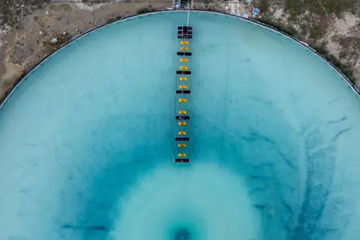Why PFAS, so called ‘forever chemicals’, are driving change in sample management
What are PFAS?
Establishing collection and sample management protocols for pervasive per- and polyfluoroalkyl substances (PFAS) is time consuming and complex for laboratories worldwide. PFAS testing requirements and legislation are rapidly developing as scientists build a better understanding of the impact of these chemicals. And the pressure is on laboratories to meet these changing demands. So, why is PFAS testing on the rise and how can we support analytical testing laboratories in meeting this challenge?
PFAS are a group of manufactured chemicals developed in the 1940s. Because PFAS resist heat, grease, and water, they have become commonplace in the manufacturing of industrial and household goods.
- PFAS are a group of nearly 9,000-15,000 synthetic chemicals
- PFAS are not naturally occurring in the environment
- PFAS molecules have a chain of linked carbon and fluorine atoms; because the carbon-fluorine molecular bonds are among the strongest, PFAS do not degrade well in the environment
- PFAS levels are known to accumulate over time
PFAS are increasingly regarded as contaminants, so-called “forever chemicals,” because they bioaccumulate in living organisms. More research is needed to fully understand the long-term effects of exposure to humans, animals, and the environment.
Places where PFAS are present
PFAS are found in:
- Water (rain, watersheds and groundwater)
- Soil
- Air
- Food
- Animals (including fish and livestock)
- Household items
- Drinking water
- Human and animal tissues and blood
- Waste (including refuse, biosolids and wastewater)
- High prevalence in soil near and water downstream from manufacturing sites, military locations, and airports
Common sources of PFAS
PFAS are found in many man-made industrial and household products. Most people’s exposure to PFAS comes from food, passed along in the food chain. Plant, animal, and seafood tissues contain PFAS from soil, air, or water. If used for food, plants, animals, and seafood are likely to contain additional PFAS levels from contact with packaging materials.
Scientists cite these common sources of PFAS:
- Waterproof clothing and shoes
- Ski wax
- Stain-resistant carpet
- Fire extinguisher foam
- Electronics
- Chrome plating processes
- Non-stick cookware
- Food packaging
- Household cleaning products
- Paints and sealants
- Personal care products
- Fertilizers made from biosolids
How are Clinisys clients using Clinisys Laboratory Solutions™ to manage PFAS testing?
Most Clinisys clients performing PFAS testing are using Clinisys Environmental Laboratory™ or Clinisys Water Quality Laboratory™ laboratory information management system (LIMS) software. “In the LIMS, PFAS testing is just another multistep analytical procedure with an automated instrument import,” explains Robert Benz, Sales Enablement Manager at Clinisys. “There’s nothing particularly different or difficult about setting up those procedures from a testing point of view,” he says. “However, our clients are having to spend lots of extra effort establishing collection and sample management protocols for PFAS testing.”
To accurately test for PFAS, it is critical that laboratory sample management processes from receipt to final result do not add or remove PFAS from the sample. “That was the tough part”, commented Clinisys customer Jenny Cahoon, QA/QC Coordinator at Legend Technical Services of Arizona, Inc. “PFAS testing presents its own challenges because PFAS is virtually ever-present. It has been a lot of work to research, study, and change our sample handling processes from end to end.” Like Legend, labs testing for PFAS likely have to retrofit lab equipment, account for PFAS adhesion and adsorption issues, and source alternative laboratory supplies to protect sample data integrity.
How can Clinisys Laboratory Solutions™ help analytical laboratories manage PFAS testing going forward?
Clinisys is not only preparing to help more of its customers offer PFAS testing services, but also to support the inevitable changes in PFAS testing requirements and regulations around the world. Today, not all 9,000-15,000 PFAS are regulated in the US, and of the ones that are regulated, not all are regulated the same between industries. For example, PFAS analytes and levels in drinking water differ by US state, and the US food industry, by contrast, does not have regulatory requirements for PFAS testing.
“We are already preparing Clinisys Laboratory Solutions to support our customers on both fronts — scale and compliance — as regulation and management of PFAS is immature, with research, data studies, and pilot programs taking place while draft regulations are finalised.” says Johnny Mihai, Director of Product Packaging at Clinisys. “With national and global attention on PFAS and emerging treatment technologies, testing labs will want and need to increase their PFAS testing capabilities while simultaneously adapting to meet each new PFAS regulation that comes into effect. Our laboratory customers span water quality, wastewater management, food & beverage, consumer products, soil, air, and human and veterinary toxicology testing services, and there’s a lot of opportunity to expand PFAS testing services in each one,” continued Mihai. “All of us in the testing industry will need to watch this space closely to see how these new opportunities for analytical laboratories evolve.”
References:
https://atsdr.cdc.gov/pfas/index.html
https://www.niehs.nih.gov/health/topics/agents/pfc/index.cfm
Related content

6 guidelines to help you choose the right LIMS for your environmental laboratory
When choosing a new laboratory information management system for your environmental laboratory, be sure to follow these six guidelines to help you select the right LIMS software provider.

How a LIMS enhances Environmental Monitoring
Demand for more advanced software systems for monitoring and testing water, soil, and air quality is growing rapidly. Enabling analytical testing laboratories to meet these needs requires advanced tools that enhance environmental monitoring and compliance.
